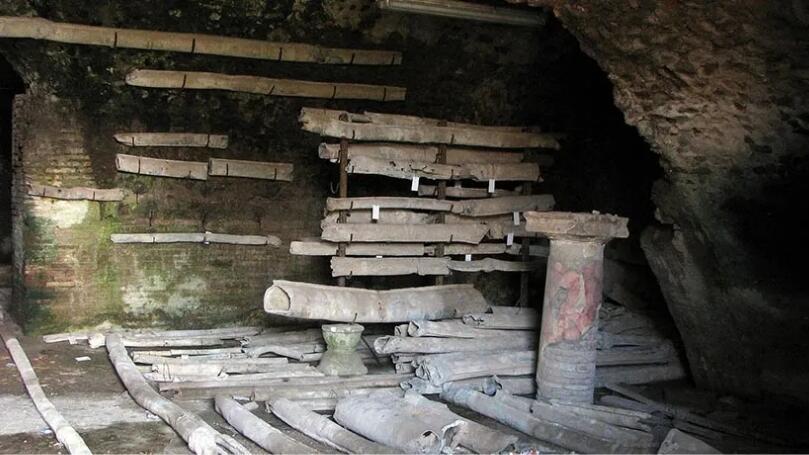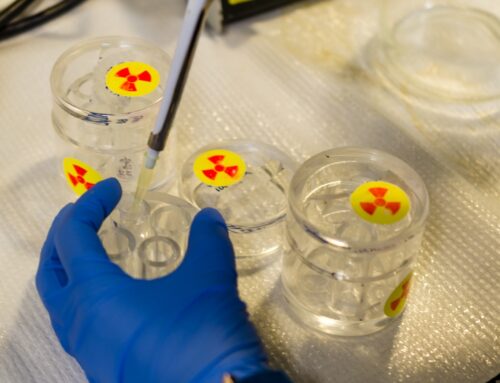Pollution through the ages: A millennia-old history
May 24, 2025
As human societies transitioned from small agricultural settlements to increasingly larger urban centers, they underwent sweeping changes in culture, technology, the environment, and more. The concentration of dense housing and the rise of industries such as food production and textiles within these cities led to a growing number of pollution sources—many of which continue to affect our environment and health today.
Although we often associate these developments with the Industrial Revolution and assume that awareness of pollution only emerged in the 20th century, concern about its effects actually dates back to antiquity—the period between the development of writing and the fall of the Roman Empire. Even then, people recognized the dangers of pollution and took steps to limit its impact.
3 View gallery

Mud deposits in ancient lead pipes in Rome allow researchers to trace the city’s development and track changes in pollution levels over time
(Photo: Chris 73/Wikimedia Commons, CC BY-SA 3.0)
Evidence of pollution in the ancient Greek and Roman empires appears alongside broader environmental changes such as deforestation and agricultural expansion. A recent study found evidence of lead pollution in the Aegean Sea —between modern-day Greece and Turkey—originating from human activity as far back as 5,000 years ago.
Around 2,600 years ago, with the rise of the Roman Empire and the growth of mining operations, lead pollution increased significantly. According to the study, this pollution began appearing on land about 2,200 years ago. The Roman period was marked by sweeping social and economic changes that both drove and were driven by rapid technological development. Mining and metal processing became vital industries, supplying metals for a wide range of everyday uses.
However, these processes were complex and highly damaging to the environment, leading to soil and water contamination. Before the Roman era, pollution was mostly localized, affecting only the immediate vicinity of the polluting activity. But as metal production expanded, pollution began to spread far beyond city boundaries, impacting broader ecosystems.
Lead was a primary source of this pollution in the Roman world. A soft, easily worked metal, it was widely used during the Roman period. Silver—also in high demand—was extracted from galena, a mineral composed largely of lead, meaning that silver mining and processing further contributed to widespread lead contamination.
The water pipes in Roman cities were made of lead, as were tools and utensils. Today, we know that lead is a toxic substance. Even minimal exposure can damage various bodily systems, including the nervous, immune, and muscular systems.
Because of its lasting presence and harmful effects, residual lead in the environment is now recognized as a major pollutant. Some scholars speculate that the widespread use of lead played a role in the eventual decline of the Roman Empire.
Lead wasn’t the only pollutant in the ancient world. Air pollution was a well-known issue for the inhabitants of the Roman Empire, frequently mentioned in contemporary writings. In some cases, laws were even enacted in an attempt to curb it.
3 View gallery

Mining and metal processing also contaminated the sea. Lead pollution from ancient activity has been detected along the Aegean coastline
(Photo: Nefeli Kavvada/Unsplash)
The use of fire for heating and lighting dates back nearly a million years. Until the advent of electricity, fires were regularly lit inside homes for warmth, cooking, and illumination, with wood and animal dung serving as the primary fuels.
While less common in some regions today, burning wood and coal is still widely used in many parts of the world for household heating and cooking. While electricity may have moved coal burning away from residential areas, as long as fossil fuels—especially coal—are used for power generation , pollution continues.
Fire, especially when used in enclosed spaces, generates large amounts of smoke and soot—both of which posed serious risks to human health and the environment in the ancient world. Evidence of this comes from a study that examined mummified remains and analyzed the lungs, revealing carbon deposits in the lungs of the deceased, which appeared as black spots during autopsy.
Fire was essential for daily household tasks such as cooking, heating, and lighting, making it a routine part of life. However, its effects extended beyond those who used it, impacting others and the surrounding environment as well as other living beings.
Get the Ynetnews app on your smartphone: Google Play: https://bit.ly/4eJ37pE | Apple App Store: https://bit.ly/3ZL7iNv
In addition to the uses we are familiar with, in antiquity smoke was used to repel mosquitoes. While it may have been effective, the smoke itself likely contributed to the development of respiratory diseases.
Fire is a chemical reaction between oxygen—typically from the air—and a combustible material. In poorly ventilated spaces, where oxygen is limited relative to the amount of fuel, incomplete combustion occurs. This process produces harmful substances such as carbon monoxide and soot—pollutants harmful to the environment and to human health.
Carbon monoxide is a toxic gas, while soot—visible as black smoke from fires—consists of fine particulate matter—a mixture of solid particles and liquid droplets suspended in the air. Inhaling these particles leads to respiratory damage and.
In fact, a high concentration of particulate matter is one of the key indicators of what we define as air pollution today. In ancient times, households relied heavily on open fires for cooking, heating, and lighting. As a result, particulate matter from domestic combustion was the primary source of air pollution.
Today, most developed countries have air quality regulations designed to limit pollutant emissions. In antiquity, however, the only practical way to mitigate pollution was by distancing its sources from population centers. Historical texts from Rome and the Land of Israel describe efforts to manage pollution through urban planning.
In these regions, polluting activities were often placed outside city limits, with the goal of dispersing harmful substances and reducing exposure. Vitruvius, a Roman architect and engineer, emphasized this approach in his writings on architecture and city planning.
He recommended considering wind direction when designing urban layouts to prevent the buildup of smoke and toxic fumes. Even in ancient times, soot and vapors were recognized as harmful, and efforts—at least in theory—were made to protect the public from inhaling them.
Soil pollution resulting from irrigation practices also posed significant challenges in the ancient world, particularly with the rise of agriculture and the early stages of urbanization. In Sumer – one of the earliest known civilizations, located between the Tigris and Euphrates rivers in present-day Iraq – irrigation was extensively used for both agriculture and gardening.
3 View gallery

The production of silver coins caused significant environmental pollution. A hoard of Roman silver coins, discovered in Poland in the 18th century
(Photo: Gabinet Numizmatyczny D. Marciniak, CC-BY-3.0)
However, this practice led to water saturation of the soil and a rise in groundwater levels. As the groundwater rose, it dissolved salts in the soil, increasing the soil’s alkalinity. When the water evaporated or drained away, it left behind a thin layer of salt on the surface, rendering the soil impermeable and unsuitable for farming. Although this process didn’t release pollutants in the modern sense, it remains a clear example of human activity damaging the environment and public health.
In this case, the harm was caused by excessive salt accumulation. The resulting soil degradation reduced the land’s agricultural viability, and some researchers believe that this environmental decline contributed to the fall of the Sumerian civilization, which struggled to implement sustainable farming practices.
Today, we understand that moving pollutants away from densely populated areas may reduce immediate harm to the health of local residents, but it doesn’t solve the problem—it merely shifts it elsewhere. True prevention requires reducing or eliminating the release of pollutants altogether, often through chemical processes designed to alter the nature or quantity of harmful substances entering the environment.
Power plants and vehicles, for example, are usually equipped with catalytic converters—devices that chemically bind harmful substances and thus filter the exhaust emitted during fuel combustion. Similarly, wastewater treatment facilities use chemical and biological methods, including bacteria, to break down and remove hazardous substances from water before it is released back into the environment.
Yet even today, metals continue to contaminate the environment, and air pollution remains a serious issue, contributing to millions of deaths each year. There is no doubt that these environmental issues affect both human health and the planet. Yet these problems are far from new. In fact, environmental pollution also serves as a lasting imprint of human activity from the distant past—traces that stretch back thousands of years into our shared history.
-
Content distributed by the Davidson Institute of Science Education.
Search
RECENT PRESS RELEASES
Related Post




